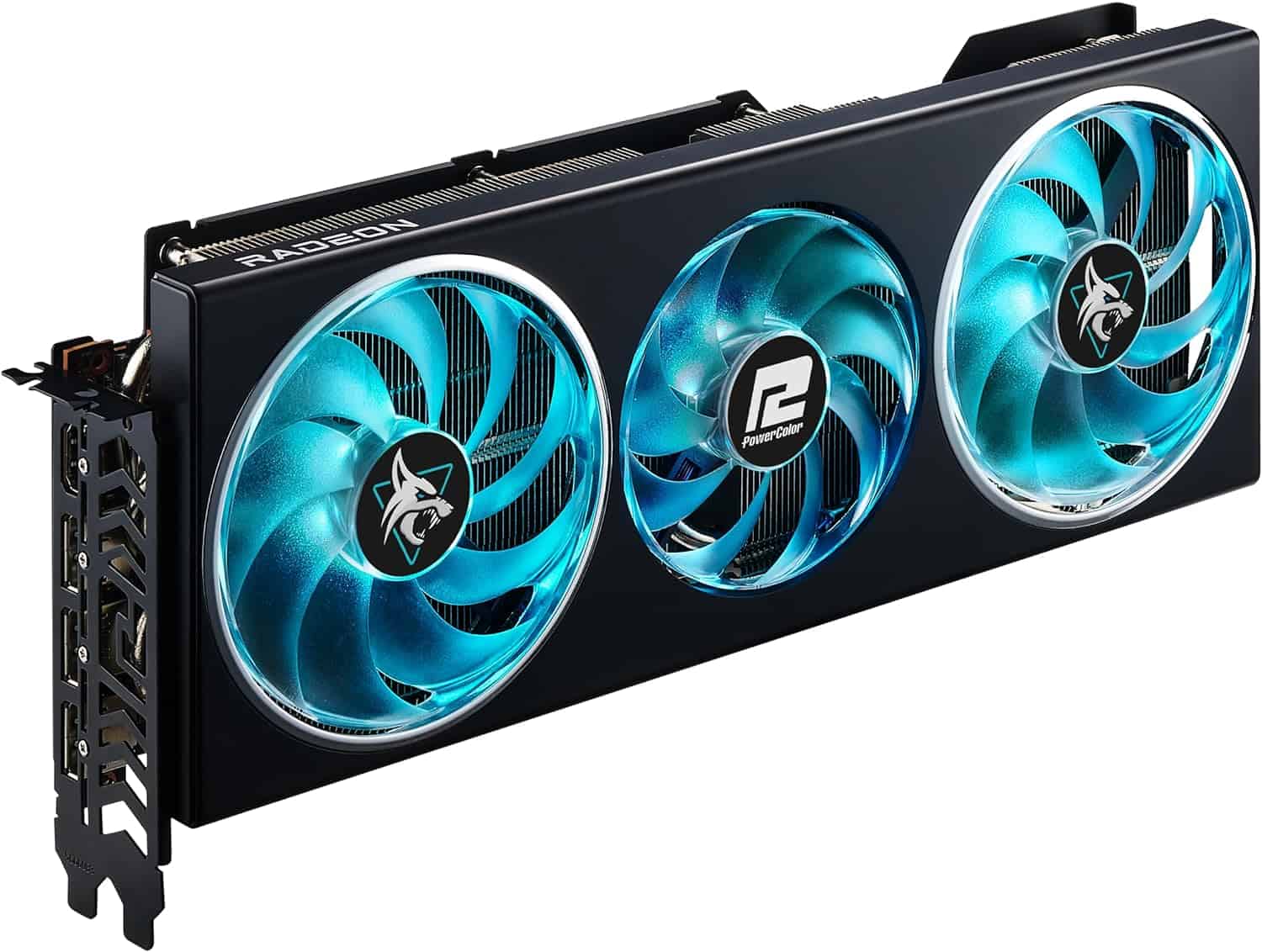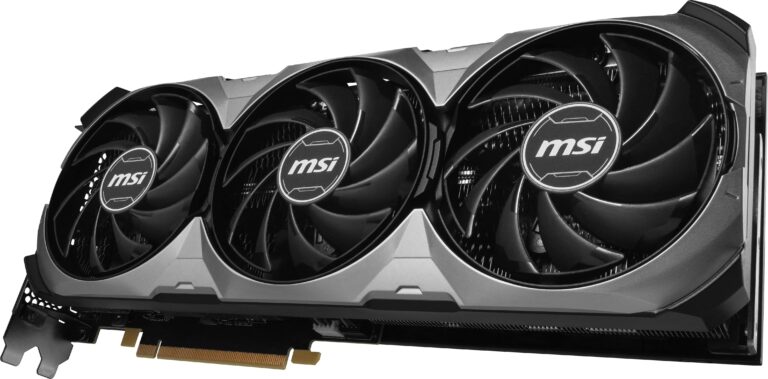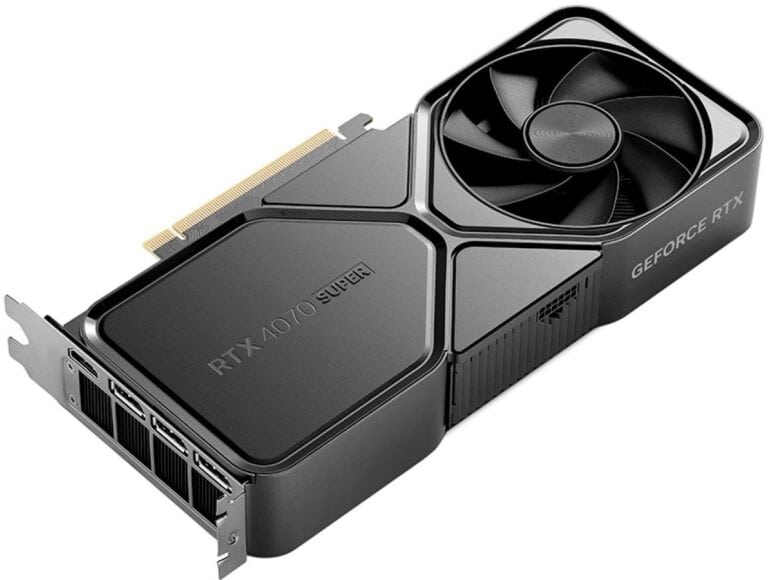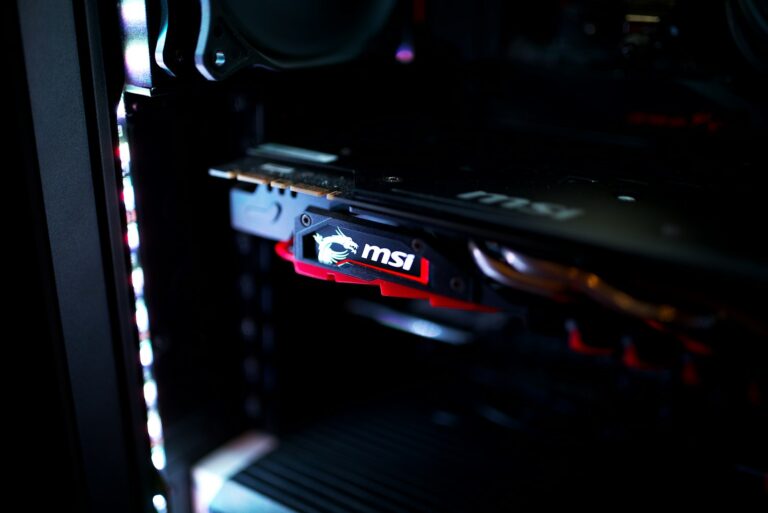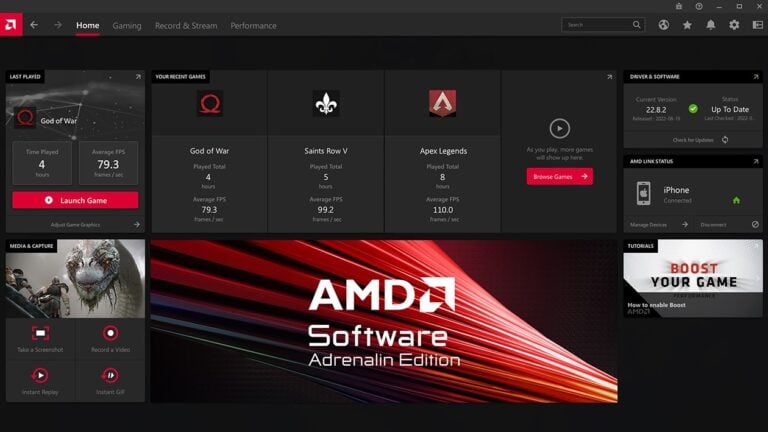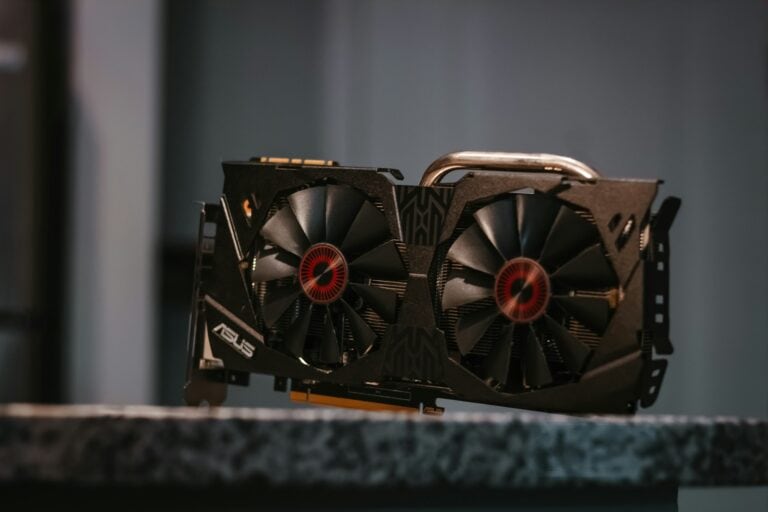When choosing a graphics processing unit (GPU), you have two main options: AMD and Nvidia. AMD’s Radeon series is known for its competitive prices and strong software features, while Nvidia’s GeForce line is recognized for high performance and innovation in technologies like real-time ray tracing.
In the last cycle, AMD debuted its Radeon RX 7000 series and Nvidia unveiled the RTX 40-series GPUs and rumors are that refreshes for both lines are in the works. These new products offer improved performance and power efficiency, giving consumers more options. When comparing AMD and Nvidia, it’s important to consider factors such as price, power consumption, and software features like Nvidia’s DLSS and AMD’s FidelityFX Super Resolution, not just raw performance.

Dueling Titans of Graphics
For anyone building or upgrading a PC, the choice between AMD Radeon and Nvidia GeForce graphics cards is a perennial debate. Both companies offer a wide range of GPUs, from budget-friendly options to high-end powerhouses, each with distinct strengths and weaknesses. Understanding these differences is key to making the right decision for your specific needs, especially with new architectures and technologies constantly emerging.
AMD Radeon vs. Nvidia GeForce: A Head-to-Head Guide
In 2025, both AMD and Nvidia continue to push the boundaries of graphics technology, focusing heavily on raw performance, ray tracing capabilities, and AI-driven upscaling.
Key Strengths and Weaknesses
AMD Radeon (e.g., RX 9000 Series)
- Strengths:
- Price-to-Performance Ratio: AMD has often been competitive, particularly in the mid-range, offering strong rasterization performance for the money.
- Open-Source Technologies: AMD generally embraces open standards, making technologies like FreeSync (adaptive sync monitors) and FSR (FidelityFX Super Resolution) more broadly compatible across hardware, including older GPUs and even Nvidia cards in some cases.
- VRAM: AMD cards often come with more VRAM at a given price point, which can be beneficial for high-resolution gaming, demanding textures, and content creation.
- AMD Software: Adrenalin Edition: This software suite is generally well-regarded for its comprehensive features, including robust overclocking tools, fan controls, and game optimization features all in one place.
- Weaknesses:
- Ray Tracing Performance: While AMD’s RDNA 4 architecture (found in the RX 9000 series) has significantly improved ray tracing performance compared to previous generations, Nvidia generally maintains a lead, especially in the highest-end cards.
- Upscaling Maturity (Historically): While FSR 4 is a significant leap, Nvidia’s DLSS (Deep Learning Super Sampling) has a longer history and, for some, has historically offered superior image quality, especially in earlier iterations. DLSS is also often more widely integrated into games.
- Ecosystem Features: Nvidia’s ecosystem of features like Broadcast and Reflex, while AMD has its equivalents, are often cited as more mature or widely adopted.
Nvidia GeForce (e.g., RTX 50 Series)
- Strengths:
- Ray Tracing Dominance: Nvidia’s dedicated RT Cores typically give them a performance edge in ray-traced games, offering a smoother and more visually impressive experience when ray tracing is enabled.
- DLSS (Deep Learning Super Sampling): DLSS leverages AI to upscale lower-resolution images to higher resolutions with impressive image quality, significantly boosting performance in supported titles, often with better stability and detail retention than FSR, particularly in its earlier generations. DLSS is also very widely adopted.
- Ecosystem & Software: Nvidia’s ecosystem includes technologies like Reflex (for reduced input latency), Broadcast (AI-powered voice and video enhancements), and a generally more mature set of features that appeal to streamers and competitive gamers. The NVIDIA App is also constantly improving its functionality.
- Top-Tier Performance: Nvidia often holds the crown for the fastest single graphics card, offering the absolute best performance for enthusiasts seeking uncompromised 4K gaming and high refresh rates.
- Weaknesses:
- Price: Nvidia cards often come at a premium, especially their high-end offerings, which can make them less accessible for budget-conscious buyers.
- VRAM (Historically in Mid-Range): In some past generations, Nvidia’s mid-range cards offered less VRAM than comparable AMD counterparts, which could become a bottleneck in certain scenarios. However, this has been addressed in newer generations like the RTX 50 series.
- Proprietary Technologies: Nvidia’s primary adaptive sync technology, G-Sync, requires a specific module in monitors, making FreeSync more widespread and generally cheaper for users.
Key Technologies Compared
| Feature Category | AMD Radeon Technologies | Nvidia GeForce Technologies | Description |
| Upscaling | FidelityFX Super Resolution (FSR): Open-source, works on a wide range of GPUs (including Nvidia), good performance boost. FSR 4 aims to close the image quality gap. | Deep Learning Super Sampling (DLSS): AI-powered, leverages Tensor Cores, generally excellent image quality, widely adopted in games. | Boosts frame rates by rendering games at a lower resolution and then upscaling them to a higher one using AI or advanced algorithms. |
| Ray Tracing | RDNA 4 Ray Tracing Accelerators: Significant improvements in current generation, offering better performance than previous AMD generations. | RT Cores: Dedicated hardware for accelerating ray tracing computations, generally leading to superior performance and visual fidelity in ray-traced titles. | A rendering technique that simulates the physical behavior of light to produce highly realistic lighting, reflections, and shadows. |
| Adaptive Sync | FreeSync / FreeSync Premium / FreeSync Premium Pro: Open standard, widely adopted by monitor manufacturers, offering tear-free gaming. | G-Sync / G-Sync Ultimate / G-Sync Compatible: Proprietary technology, G-Sync requires a dedicated hardware module in the monitor for best performance. G-Sync Compatible works with certain FreeSync monitors. | Synchronizes the refresh rate of the monitor with the frame rate of the GPU, eliminating screen tearing and stuttering. |
| Latency Reduction | Radeon Anti-Lag / Radeon Boost / HYPR-RX: Suite of technologies to reduce input lag and dynamically adjust resolution for performance. | Nvidia Reflex: Optimizes game and system latency, particularly beneficial for competitive gaming. | Technologies designed to minimize the delay between user input and on-screen action, providing a more responsive gaming experience. |
| Streaming/Content | AMD Software: Adrenalin Edition Encoder: Robust encoder for streaming and recording. AMD Noise Suppression: AI-powered background noise reduction. | NVENC Encoder: Dedicated hardware encoder, highly efficient for streaming with minimal performance impact. Nvidia Broadcast: AI-powered effects for microphones, webcams, and virtual backgrounds. | Features and hardware acceleration designed to improve the quality and performance of live streaming and video content creation. |
| Driver Software | AMD Software: Adrenalin Edition: Comprehensive suite with performance tuning, monitoring, and game optimization. | NVIDIA App / GeForce Experience: Offers driver updates, game optimization, and access to Nvidia-specific features. | The control panel and utilities provided by the GPU manufacturer for managing settings, updating drivers, and optimizing games. |
Which One is Right for You?
- For the Absolute Best Performance & Ray Tracing: If your budget allows and you prioritize cutting-edge ray tracing performance and the highest frame rates at the highest resolutions (e.g., 4K gaming), Nvidia’s flagship offerings often have an edge.
- For Value and Rasterization Performance: If you’re looking for strong traditional rasterization performance per dollar, especially in the mid-range, and are less concerned with having the absolute best ray tracing, AMD often provides compelling options. Their higher VRAM capacities can also be a plus for future-proofing.
- For Esports & Competitive Gaming: Both offer latency reduction technologies. Nvidia’s Reflex has a strong reputation, but AMD’s offerings are continually improving. The choice here might come down to specific game optimizations.
- For Content Creators: Both companies offer excellent acceleration for content creation applications. Nvidia has historically been stronger in certain professional applications due to CUDA core dominance, but AMD’s Radeon Pro line and recent RDNA architectures are increasingly competitive, especially with AI acceleration for tasks like video editing and 3D rendering.
- Monitor Compatibility: If you already own a FreeSync monitor, an AMD card will seamlessly integrate. If you have a G-Sync monitor, an Nvidia card will provide the full benefits. Many FreeSync monitors are now G-Sync Compatible, but native G-Sync is often considered superior.
Ultimately, the choice between AMD Radeon and Nvidia GeForce comes down to your specific needs, budget, and priorities. Both companies are innovating rapidly, and the competition benefits consumers by driving technological advancements and competitive pricing. Always check recent benchmarks and reviews for the specific cards you are considering, as performance can vary between generations and specific models.
Performance
Nvidia holds an edge in raw power, particularly with its top-tier GPUs like the RTX 4090, which boasts unparalleled performance for high-resolution gaming and demanding tasks. AMD’s latest Radeon RX 7900 XTX offers comparable performance at a more budget-friendly price, making it a compelling choice for gamers seeking value.
Features
Nvidia’s DLSS (Deep Learning Super Sampling) technology stands out, enhancing performance by using AI to upscale lower-resolution images. This can significantly boost frame rates without sacrificing image quality. AMD’s alternative, FSR (FidelityFX Super Resolution), is open-source and works across both AMD and Nvidia GPUs.
Ray Tracing
Ray tracing simulates the behavior of light for realistic reflections and shadows. While both companies offer ray tracing capabilities, Nvidia has a stronger track record and wider adoption of this technology in games. However, AMD is making strides in this area, with its latest GPUs offering competitive ray tracing performance.
Price
AMD traditionally offers better value for money, with its GPUs often delivering similar performance to their Nvidia counterparts at a lower price. This makes AMD a popular choice for budget-conscious gamers who don’t want to compromise on performance.
Software and Drivers
Nvidia’s drivers and software are generally considered more polished and user-friendly. However, AMD has made significant improvements in recent years, and its drivers are now more reliable and stable.
Comparison Table
| Feature | Nvidia | AMD |
|---|---|---|
| Raw Performance | Stronger at high end | Competitive at lower price points |
| DLSS/FSR | DLSS (exclusive to Nvidia GPUs) | FSR (works on both Nvidia and AMD GPUs) |
| Ray Tracing | More established, wider adoption in games | Catching up, competitive performance |
| Price | Typically more expensive | Better value for money |
| Software and Drivers | More polished and user-friendly | Improved in recent years |
Key Takeaways
- AMD and Nvidia offer distinct advantages in GPU technology, with AMD often priced more competitively.
- New GPU series from both companies have raised the bar in performance and energy efficiency.
- The debate between AMD and Nvidia goes beyond performance to include pricing, power consumption, and software features.
Overview of AMD and Nvidia
In the arena of graphics processing, AMD and Nvidia stand as titans, each bringing their unique advancements to the technology of GPUs. This section explores their historical context, technological innovations, software support, and ecosystem compatibility.
Historical Context and Market Position
AMD (Advanced Micro Devices) and Nvidia have been competing in the graphics card market for many years. AMD, known for its Radeon series, and Nvidia, with its GeForce line, have both significantly impacted the gaming and professional graphics card landscapes. While Nvidia has generally held a larger share of the market, AMD’s offerings, particularly with the introduction of RDNA architectures, have strengthened its position.
Architecture and Technology
Nvidia’s architectures, such as Turing and later Ampere, offer advanced ray tracing capabilities and AI-driven processes. AMD’s RDNA and RDNA 2 technologies focus on high throughput and efficiency, introducing features like the Infinity Cache. Both brands support GDDR6 memory, enhancing bandwidth and speed.
Software and Driver Support
Software and driver support are critical for the performance of graphics cards. Nvidia’s GeForce Experience software provides users with a suite of tools for optimizing gameplay, while AMD’s Radeon Software aims for a similar goal with its own feature set. Drivers from both companies are regularly updated to improve performance and compatibility with new games and applications.
Brand Ecosystems and Compatibility
The ecosystems surrounding AMD and Nvidia involve more than just graphics cards. Considerations such as Nvidia’s G-Sync and AMD’s FreeSync technologies ensure smooth frame rates on compatible monitors. Additionally, features like Nvidia’s Resizable BAR and AMD’s Smart Access Memory improve data flow between the CPU and GPU when paired with certain motherboards. Compatibility within these ecosystems can significantly influence a user’s experience.
Performance, Pricing, and Features Comparison
When looking to buy a new graphics card, comparing AMD Radeon to Nvidia is key. Factors like gaming performance, pricing, unique features, and technology offerings by both companies make a big difference in deciding which GPU to pick.
Gaming Performance across Resolutions
For gamers, how well a GPU can run games at 1080p, 1440p, and 4K is critical. Nvidia’s RTX 4070 Super and higher models are well-known for their strong performance in games like “Metro Exodus” and “Shadow of the Tomb Raider,” especially with ray tracing enabled. On the other hand, AMD’s top card, the Radeon RX 7900 XTX, is a powerhouse as well, though it sits behind Nvidia in ray tracing capabilities.
- 1080p Gaming: Both brands deliver more than adequate frame rates in this resolution.
- 1440p Gaming: Nvidia GPUs may have a slight edge in higher resolutions.
- 4K Gaming: Here, premium cards like the RTX 3090 or the RX 6900 XT are necessary to maintain high frame rates.
Key Features and Technologies
Nvidia GPUs boast RTX technology, enabling advanced ray tracing and AI features such as DLSS (Deep Learning Super Sampling). AMD counters with FidelityFX Super Resolution and DirectX Raytracing, enhancing image quality and performance.
- Ray Tracing: Nvidia is ahead, with dedicated hardware for the task.
- AI Features: Both companies use AI for image upscaling, but Nvidia’s DLSS is currently more widespread.
Benchmark Analysis and Reviews
Benchmarks from trusted sources like Tom’s Hardware and PC Gamer give insights into a GPU’s raw performance. These reviews highlight that Nvidia GPUs often outperform their AMD counterparts in specific benchmarks and game tests.
- Benchmarks: Tests like those for “Metro Exodus” show Nvidia’s lead in performance.
- Reviews: They suggest considering individual gaming needs, as some AMD GPUs excel in value.
Price-to-Performance Ratio
The price of a GPU compared to its gaming performance is a crucial factor.
- High-End Models: Nvidia’s RTX 3080 Ti and AMD’s RX 6900 XT provide top-tier performance but at a premium.
- Entry-Level Models: AMD’s offerings like the RX 6500 XT may offer better value for those on a budget.
Product Offerings and GPU Segments
Each company has a lineup catering to different market segments from entry-level to high-end gaming PCs. Nvidia’s latest RTX 40 series and AMD’s Radeon RX 7000 series span a wide variety of performance points and price levels.
- Nvidia RTX 3060, RTX 3070 – Popular for mid-range gaming PCs.
- AMD Radeon RX 6700 XT, RX 6600 XT – Compete in a similar segment, often with a more attractive MSRP.
Frequently Asked Questions
In this section, we explore some common queries about AMD Radeon and Nvidia graphics cards. These questions aim to address the main concerns of consumers looking to understand the differences between these two graphics card manufacturers.
What are the current performance differences between AMD Radeon and Nvidia GPUs?
AMD Radeon RX 7000 series launched in December 2022 and competes closely with Nvidia RTX 40 series, offering strong performance at 1440p and 4K resolutions. While Nvidia tends to excel in the high-end market, AMD offers competitive options with the Radeon RX 7900 XT and RX 7900 XTX models.
How do AMD Radeon GPUs compare to Nvidia’s in terms of power efficiency?
Nvidia’s architecture often leads in power efficiency, especially with their RTX 30-series GPUs. Despite this, AMD has made significant improvements in power efficiency with the RX 7000 series, narrowing the gap between the two manufacturers.
Which offers better value for gamers: AMD Radeon or Nvidia graphics cards?
AMD Radeon graphics cards traditionally offer better price-to-performance ratios, especially in the mid-range segment. For example, the Radeon RX 6800 XT offers competitive gaming performance at a lower cost compared to the Nvidia RTX 3080.
What are the software and driver support differences between AMD and Nvidia?
Software and driver support might vary, with Nvidia historically providing more regular driver updates. AMD has been closing this gap, offering more frequent driver releases and improved software features with their Radeon Software Adrenalin Edition.
How do AMD Radeon graphics cards fare in ray tracing performance compared to Nvidia’s?
Ray tracing performance has been a strong suit for Nvidia, particularly with their RTX series enabled by dedicated ray tracing cores. AMD’s latest cards including ray tracing technology, however, are advancing and present promising performance.
In terms of future-proofing, which is more reliable: AMD or Nvidia graphics technology?
Both AMD and Nvidia are committed to future-proofing their graphics cards through hardware and software innovations. Choosing between them for future-proofing depends on specific use cases and the types of games or applications you plan to run.

